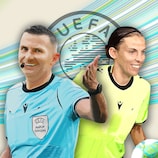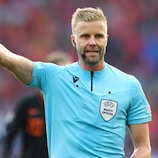Refereeing must develop constantly to meet the demands of the modern-day game. Alongside our member associations, we take great care in nurturing and promoting officials – fostering both elite and up-and-coming referees.
Refereeing news
The latest updates from the world of refereeing, featuring news on officials, laws of the game and interviews with UEFA's match officials.
Referee development
Article summary
Refereeing must develop constantly to meet the demands of the modern-day game, and UEFA's refereeing activities have kept pace.























